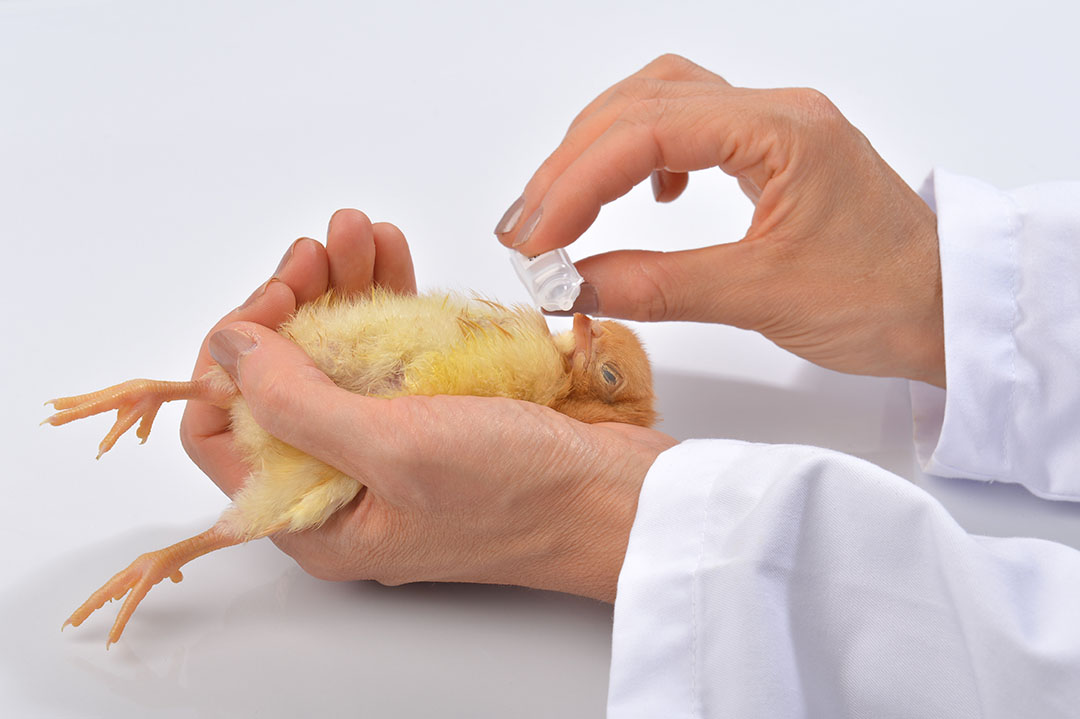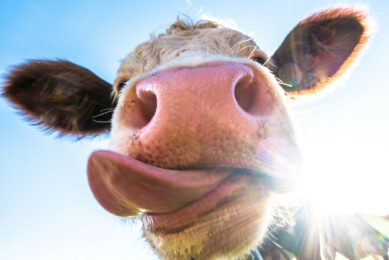The necessity of flavourings in animal production

Flavourings have been used for many years in animal feed in order to guarantee its palatability. However, flavourings can go beyond just the aromatic note and bring functionalities to help animal production. How can flavourings be beneficial to animal production?
Animals are far more equipped than humans to smell and to taste what they eat. For example, a cow has 20,000 taste buds, when humans have only around 4600. The olfactory epithelium, essential to smell and taste, has a surface of around 30,000mm² in wild swine, and only 1125mm in humans.
All animals have natural sensibilities to olfactory molecules and the Porter Method adapted sets out the way to identify olfactory molecules which attract the animals or on the contrary that repel them. This recognised scientific protocol uses the chick model: chicks do have olfactory receptors and are easy to handle. The principle consists in observing the reaction of the chicks when a specific olfactory molecule is presented to its beak, where it has the receptors. The molecules are put in an eyedropper and either the chick shows signs of comfort and keeps its beak towards the eyedropper, or it shows discomfort and its head away from the eyedropper.
Animals also have natural preferences toward specific tastes. Young animals, like piglets or calves, have a preference for sweet. Ruminants will prefer green olfactory notes and do like some little acidity.
Using animal physiology to help production
Smell is the first contact the animal has with its feed, with taste just behind. And considering the sensibility of animals to smells and tastes, flavourings have a role to play in animal production. The benefits of flavourings for livestock animals rely on various areas of expertise that go beyond the aromatic field.
Animals are neophobic, even a small change of smell or taste, which is considered as something new in their environment, can have a negative impact on their feed consumption. Using a flavouring enables the smoothening of changes of odour and taste of the feed due to the raw materials for example, and therefore to fight against the drops in feed intake due to feed changes. On that basis, feed transitions can be accompanied by flavourings to help the animals during these critical steps.
Imprinting as a flavouring mechanism
Konrad Lorenz (1903 – 1989), zoologist, identified and characterised the imprinting, as a faculty of learning through the senses, from birth until a variable period according to the species and individual. When a human being or an animal is born, the first experience is breathing in air and the olfactory molecules that are present.
Using this mechanism of imprinting, flavourings can be handled in order to avoid drops in feed intake during weaning and feed transitions. A same flavouring, incorporated into the mother’s feed and into the following feeds of the young animals, will appear to the young animals as a stable parameter, that the animals has always known and that doesn’t change. The animals will recognise it each time and won’t see the feed as a novelty, they will then enable them to keep their feed intake up during these critical stages with greater ease.
Moreover odour and memory are closely related. Hedonic perception of an odour and its related behaviour results from memorisation of both the flavour itself and the emotional context linked to it. It is why an odour perceived during the peri-maternal stage for mammalian is always integrated as attractive and reassuring.
Combining the smoothing role with an attractant functionality, makes a flavouring key to limit drops in animal feed intake.
Good and bad tastes
Talking about nice odours and taste with flavourings seems logical, but also bad tastes. It can be due to specific raw materials, compounds, or combinations, like an important proportion of oilseed rape, or presence of minerals. As mentioned earlier animals are excellent at tasting and smelling pleasant but also bad notes. And bad taste is an important problem as they cause a drop in feed intake. Flavourings specifically developed to mask bad tastes can solve this problem to make it more acceptable by the animals and enable the feed manufacturer to still use the ingredients in question.
Feed processing and flavourings
A flavouring is composed of volatile molecules, which is logical in order to be sensed by the nose, the molecules have to be airborne.
Flavourings have 2 missions:
- Be released into the air in order to give the smell to the feed
- To stay in the feed long enough to give the feed its smell until it will be consumed
Flavouring molecules are fragile compounds, due to their volatility. Despite that fact, a flavouring for pelleted feed needs therefore to be resistant to pelletisation. Indeed, the pelletisation process will impact the flavouring also impact its persistence and intensity, and it can also slightly change its olfactory profile. Therefore, when developing a flavouring to bring defined olfactory notes, the experts have to anticipate the changes that pelletisation will bring to the flavouring. A flavouring can be developed with quite some complexity in its structure to answer the needs after pelletisation reinforcing the most sensitive molecules to resist to thermal treatment (Figure 1). But it always has to be balanced to be agreeable in its pure form and be used in non-pelleted feed. Flavourings are adapted to the industrial process at different levels of resistance before pelletisation.
Figure 1 – Example of the complexity and balanced profile of a flavouring

Tackling feed challenges with flavourings
Smell is the first step before feed ingestion, followed closely by taste. Animal physiology makes them very sensitive to smell and taste, hence the essential role flavouring can play into the feed.
By improving the smell and taste of the feed, flavourings are an answer to feed challenges such as feed transitions, raw materials changes, bad tastes. On the taste front sweeteners are an excellent option to flavourings in order to boost the palatability of a feed.
Considering all the above, the current feed challenges animals are facing and the high production awaited, this is why flavourings have become a necessity and a valuable tool. Flavourings are a key lever to improve animal ‘better-being’ through their feed, hence helping animal production.
References available on request
Author: Aurore de Vienne, Product Manager, Flavourings and Sweeteners, Phodé











